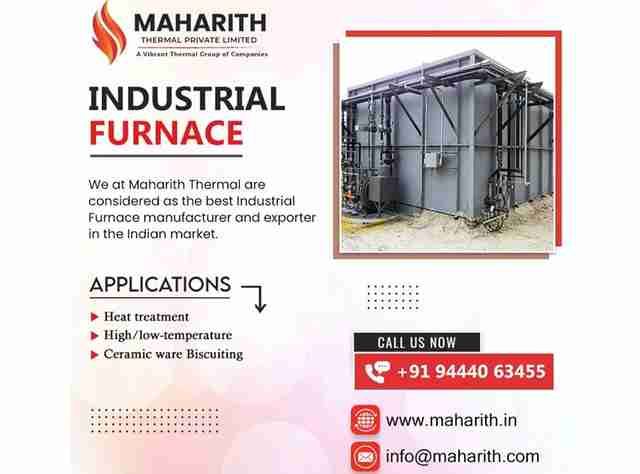The temperature in an Industrial Furnace, sometimes called a direct heater or direct-fired heater, is generally above 400 degrees Celsius and is used to facilitate various manufacturing processes. Their heat is employed in operations, or they can operate as a reactor to generate reaction heat. Many different furnaces exist, each with its unique heating capacity, fuel requirements, and means of introducing combustion air. A furnace uses fuel, air, oxygen, or electricity to produce heat. The residual heat is released as flue gas when the furnace is turned off.
What is an Industrial Furnace?
The furnace is commonly used to pre-process materials for forging and heat-treat metals for annealing, tempering, and carburizing. Furnaces are typically used to heat metals before they are shaped, but they can also be used to heat other materials like glass and ceramics. Furnaces can superheat almost any material using various fuels and forms to extremely high temperatures.
There is a clear distinction between Industrial Oven and furnaces, although both heat materials for processing. They both refer to producing heat but are often used interchangeably. The temperature range is the most noticeable distinction. While ovens typically function at temperatures between 250- and 900 degrees Fahrenheit, furnaces can reach temperatures of 2,000 degrees Fahrenheit or higher.
The configuration and design of furnaces vary. Some of them are lightweight and portable and have open shelves and doors. They have a home at research facilities that can be used in testing products or materials. Muffle furnaces are used in research and development facilities for product testing and dental laboratories for zirconia binder burnout.
Conveyor systems allow furnaces at big metallurgy plants to process enormous amounts of material quickly and efficiently. They’re entirely mechanized, with induction or direct-fired heating. The extraction process in metalworking or smelting is their primary use.
The Functioning of Industrial Furnaces
Each furnace has a unique purpose and can only burn certain fuels. For quite some time, wood and coal were the primary fuels for furnaces, necessitating frequent reloading to ensure continual heat. Automatic fuel delivery has become standard in today’s furnaces.
Functioning of a Furnace
A practical and inexpensive furnace relies heavily on its fuel. While coal and wood were used for a considerable amount of time, they both contributed to air pollution, needed to be constantly fed and made maintaining a consistent temperature challenging. Most modern furnaces, known as fuel-fired furnaces, have fuel supplied directly into the furnace at a controlled rate or use electricity to maintain a constant temperature.
The design of the furnace is based on the type of fuel being used, but this consideration is irrelevant primarily in modern heating systems. The oxygen supply is crucial to the furnace’s efficient operation, as with any heat-operated apparatus.
Both induction and resistance heating is used in electric furnaces. Because they produce no flue emissions, electric furnaces are good for the environment and their efficiency. The cost of running an electric furnace is a significant drawback.
The priciest electric furnaces employ a resistance heating system with a fan to distribute heat evenly around the room. Many different materials can be used to construct resistors, or the load itself can be used in place of one.
In induction heating, the load is encircled by a coil and electricity is passed through it. The nature of the load dictates the alternating current’s cycle rate. Water is used to cool the coils, so they don’t get too hot and break down. As the name implies, induction heating is used to heat only a specific workpiece section.
For what purposes does a large-scale Industrial furnace find the application?
At first glance, only metallurgical procedures involving metal moulding and shaping use furnaces. A commercial furnace supplied by Industrial Furnace Suppliers in India is almost always used when heated materials are necessary.
Many components in today’s technological marvels call for being plasticized or distorted before being put to use. Furnaces are often the primary heat generators, whether they use fossil fuels or electricity. Furnaces have been used successfully for reshaping and pre-treating a wide variety of items, regardless of the raw materials, fuel, or means of creating heat.
Furnaces have been used by the metallurgical industry for millennia to smelt, heat treat, and temper various metals at extremely high temperatures. Considering that they can reduce 550 pounds (250 kilogrammes) of metal to as little as 2 pounds, you can see why they are such a valuable tool (1kg). They are in demand because of the variety in their power output.
Chemical processors use furnaces to perform heat treatments and chemical synthesis. Thermal power plants utilize them to incinerate garbage or heat water for their steam turbines. They are used in the mining industry to get the metals out of the ore. Companies producing ferrous and non-ferrous metals have used furnaces for years, necessitating large-scale smelting and casting activities.
Industrial Furnace Exporters in India export a wide variety of designs to accommodate various processes. Industries that work with fuel oil often utilize furnaces to measure how much ash a specific sample produces. Samples are softened in annealing furnaces for further cold or mechanical processing. Industries as diverse as metalworking and food processing use various furnace types and configurations.
More and more industries are finding uses for furnaces as more and more mass-production technologies become available. There have been concerns about furnaces’ environmental impact, although measures have been taken to mitigate these concerns.
Conclusion:
In industry, furnaces are used for melting and heat-treating materials; hence controlling the temperature is essential. We have high-quality furnaces at Maharith Thermal Pvt. Ltd. for any such needs. As a result of the high demand for our wares, they are easily accessible in the marketplaces. As a result of our ability to produce high-quality furnaces tailored to each client’s needs and budget, we have become well-known in the industry. We are the best Industrial Furnace Manufacturers in India.
FAQs
How high can temperatures be reached in a typical furnace?
The HTF furnaces can reach maximum temperatures of 1600 C, 1700 C, or 1800 C. Molybdenum disilicide elements provide the heat for all models. The HTF commercial stove has capacities of 27, 64, 128, 165, 250, 332, and 560 litres.
What kind of Industrial furnace do factories typically use?
Heat for industrial processes typically requires temperatures above 400 degrees Celsius, which is where a furnace comes in. They can either directly supply heat to a process or act as a reactor to generate heat for a chemical reaction.
How do Industrial furnaces get their heat?
A furnace can’t produce heat without a power source or fuel. Common energy sources include electricity and combustible fuels like coal and natural gas. Gas is heated by being pumped under pressure through a pipe, while electricity is used to warm an electrical element using current.


